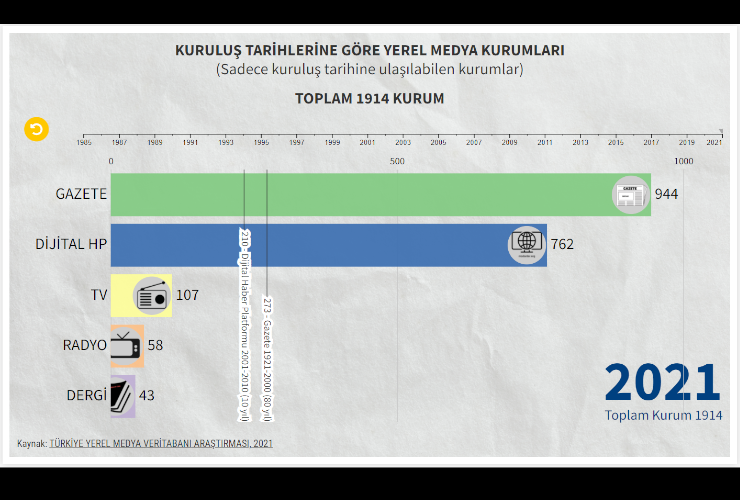The International Press Institute (IPI) re-publishes the findings of “The Local Media Database Research” conducted by the Media Research Association (MEDAR) in 2021. See the initial findings below.
The first census research examining local media in Turkey, “The Local Media Database Research”, has been published by the Media Research Association (MEDAR) with the support of the ETKINIZ EU Programme. The database research was aimed at identifying demographic profiles of local media organizations actively operating in 81 provinces in the country.
The data acquired by the research shows that the local media in Turkey mostly consists of local newspapers operating in certain regions and big cities, whereas there are significant problems challenging the survival of local journalism.
Research Methodology
In the research carried out between July 2020 and February 2021, a two-stage mixed research methodology was applied. Firstly, all existing media databases and press lists were examined in order to identify all local media organizations actively operating. Subsequently, a special web search method has been designed and applied as city-based scanning of local media organizations in every region. As a result of this detailed desk-based monitoring, in total, 3240 local media organizations were detected. In the second stage, the data in the first stage was validated and expanded with comprehensive field research including surveys conducted with 1222 local media organizations.
Outstanding Findings of the Research
(Graph 1: Geographical Distribution of the Local Media Organizations in Turkey)
The regional differences in the development of local media organizations underline the need for empowerment of local journalism in certain areas.
(Graph 2: Regional Distribution of Local Media Organizations in Turkey)
- The data shows that local media organizations are mostly located in the Marmara, Mediterranean and Aegean regions. While it is observed that there are relatively few institutions in the Black Sea and Central Anatolia regions, Eastern Anatolia and Southeastern Anatolia are the regions containing the least number of local media organizations in Turkey.
(Graph 3: City-based Distribution of Local Media Organizations in Turkey)
- The city-based distribution of the organizations reveals that local media are generally concentrated in metropolitan areas of Turkey. Considered as the centre of the mainstream media in Turkey, Istanbul takes the lead as the city with the highest number of local media organizations. Mersin, Bursa, İzmir, Adana, and Antalya are the other cities with the highest number of outlets. Strikingly, there are fewer local media organizations in the capital Ankara than in relatively smaller cities such as Kocaeli, Aydın, and Balıkesir.
News coverage in local media is mostly carried out by “newspapers” and “digital news platforms” while there is a limited number of magazines, television, and radio channels operating at the local level.
(Graph 4: Distribution of the Local Media Organizations by Institutional Type)
- The distribution of local media by institutional type shows that local media organizations generally operate within the scope of print and digital media. While the number of “newspapers” (1542) and “digital news platforms” (1197) is quite high, “magazines” (118), “radios” (263), and “televisions” (136) are limited in number. This reflects that local journalism is only sustained through certain mediums concentrating on print media, while audio-visual broadcasting at the local level needs improvement.
Despite restrictive pressures of the government, the number of local media organizations has increased since 2015.
(Graph 5: The Historical Development of Local Media Organizations in Turkey)
- The establishment dates of the local media organizations examined during the research show that since the beginning of the 2000s, the number of established organizations has increased significantly. The dramatic increase in the number of local media organizations of all types, especially after 2015, draws attention to the fact that the local media continues to develop despite the rising political and economic pressures in recent years.
Financial problems, which have become more severe during the pandemic, cause organizations in local media to withdraw from active broadcasting/publishing while also limiting their institutional capacity.
- It is known that the currently increasing financial pressures on the Turkish media sector had a negative impact on the local media, forcing many organizations to either downsize or close due to economic problems. Similarly, research data confirms that the financial contraction in the local media has reached radical levels and the pandemic has led to a serious decline in the numbers of local media organizations.
Local media organizations are improving in terms of digital publications and the usage of social media platforms
- Another noteworthy finding of the research is the high level of digital publishing/broadcasting by local media organizations. 82.6% of the surveyed local media organizations publish news through their official websites. Moreover, digital news platforms (34.6% of all organizations) stand out as the second institutional type with the highest number of organizations. These indicate that the local media has developed in terms of adaptation to digital media.
(Graph 6: Distribution of Digital Local News Platforms in Turkey)
(Graph 7: Official Website Ownership Levels of Local Media Organizations in Turkey)
- Usage of social media platforms and the platform preferences by the local media organizations also demonstrate important indications regarding the level of digitalization. The majority of the surveyed organizations (89%) publish/broadcast through social media platforms, mostly through Facebook (87.2%) and Twitter (72.3%). This shows that, similar to the mainstream media in Turkey, the local media also tries to expand their audience through digital communication platforms.
The news content in the local media depends on the national agenda, while the capacity for authentic local reporting remains limited.
(Graph 8: Distribution of News Content Themes by Local Media Organizations in Turkey)
- The majority of surveyed local media organizations produce more news content under general themes such as national agenda, politics, economy and finance. However, the level of news content produced in special journalism areas such as culture and arts, health, sports, tourism and environmental news is significantly lower. This shows that news coverage is mostly formed by prioritizing the trends in the national agenda, as in the mainstream media organizations in Turkey. On the other hand, the capacity of local media organizations remains limited in producing authentic news content on specific themes presenting the dynamics of local regions.
Local newspapers and televisions have the highest employment rates
(Graph 9: Distribution of Employees by Institutional Types in Local Media)
- According to the obtained data, a total of 4996 employees actively work in 1222 surveyed local media organizations. The distribution of employees by institutional type shows that the highest numbers of employees are working at local newspapers (3076 employees) and digital news platforms (1524 employees). However, the average number of employees per organization demonstrates that local televisions (average: 6.32 / 6-7 employees) and local newspapers (average: 4.71 / 4-5 employees) have the highest numbers of employees.
These limited staff have to multitask and the total number of field reporters remains dramatically low
The distribution of the number of employees in the local media per organization shows that an average of four employees work in each organization. Although the limited workforce is optimally assigned to vocational positions, the limited number of employees undertake multiple tasks in the organizations. Still, 40.8% of the surveyed local media organizations do not have any reporters actively producing news from the field, while the rest usually have only one field reporter (average: 1.15). These findings reveal the impact of restricted financial resources on personnel capacity in local media organizations.
The number of men working in the local media is more than twice the number of women, revealing the gender inequality in employment.
The majority (68.7%) of the personnel in the surveyed local media organizations are male employees, while the remaining 31.3% are female. In addition, the data show that 37.6% of the surveyed organizations do not have any female employees, and the average of female employees per organization is limited to between one and two employees. The very low number of female employees shows that there is a serious gender gap in the recruitment processes of the local media organizations.
To access the full research report: www.yerelmedyavt.com




